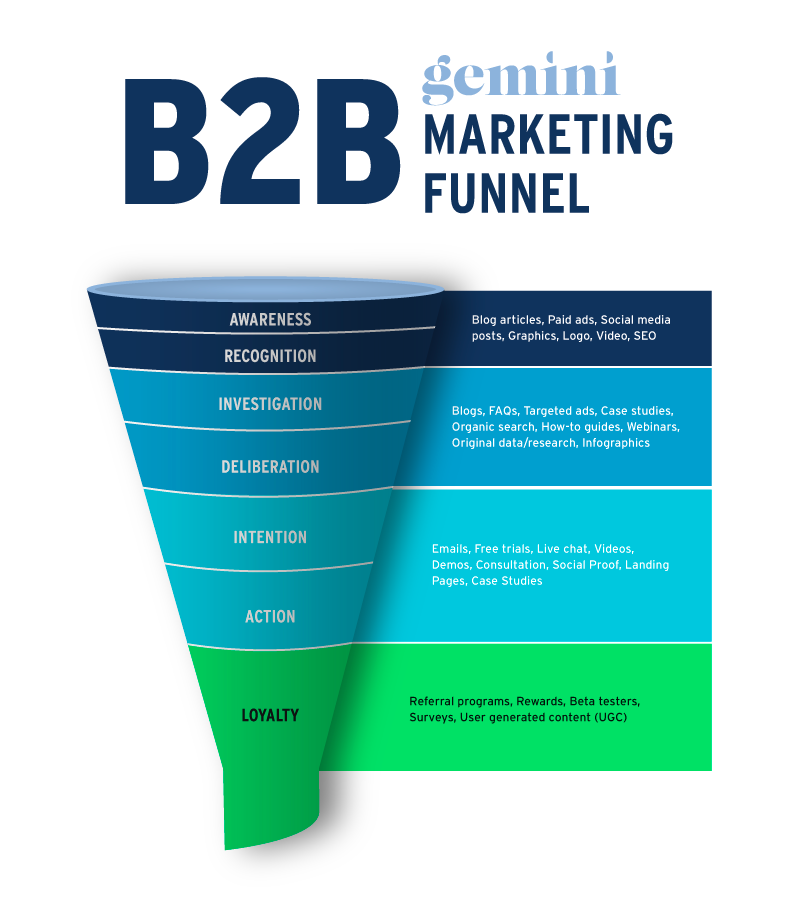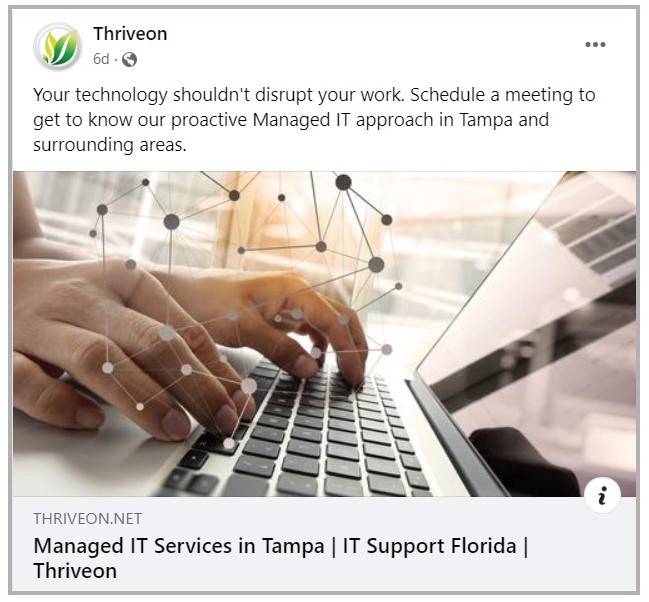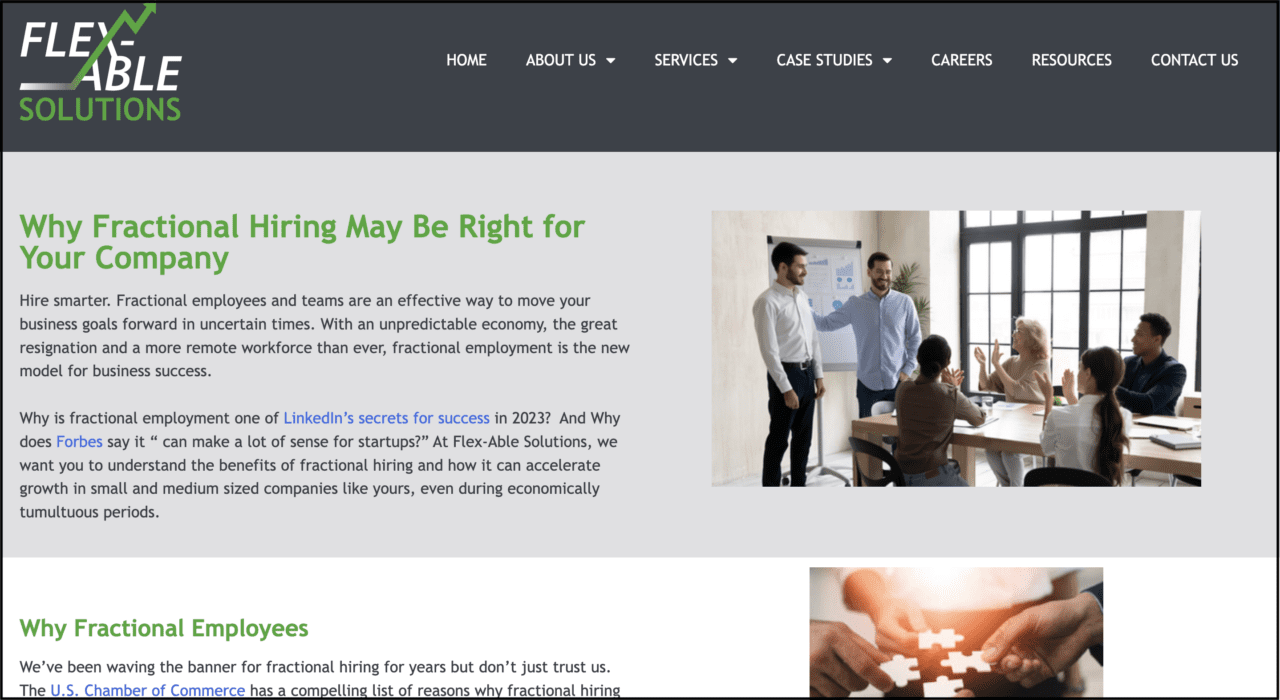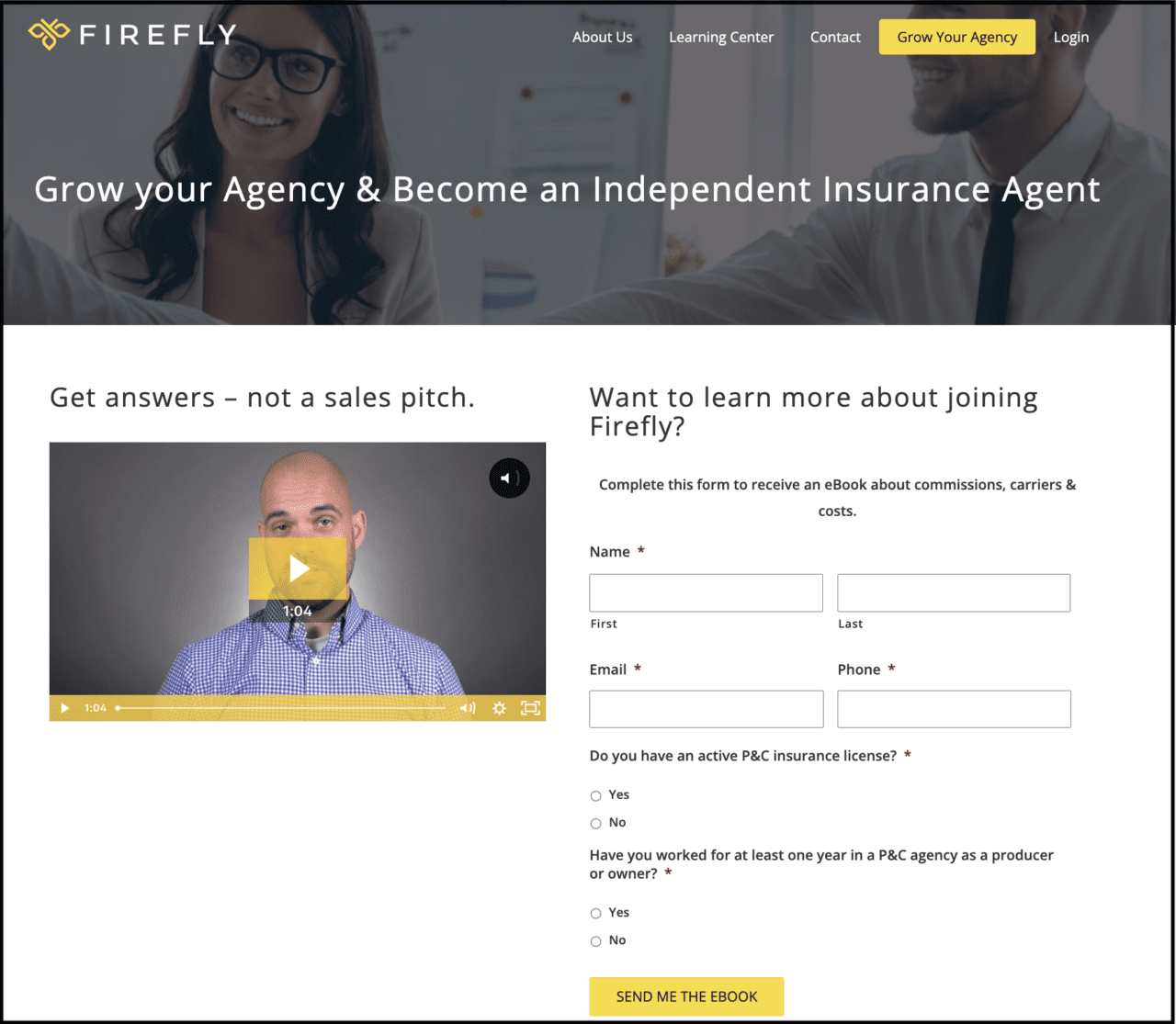
The buyer’s journey is rarely linear, especially when it comes to business to business (B2B) purchases. Customers can take an average of eight months to decide on which provider they want to trust. How do you manage buyer expectations with so much uncertainty? A well-designed funnel catches buyers at any point in their journey and gently redirects them back to you.
Constructing your B2B marketing funnel requires a clear plan that implements multiple marketing strategies at every step. Done well, a B2B funnel will maintain customers as brand advocates with below-the-funnel strategies such as loyalty programs and feedback loops. Let’s dig in by looking at the stages of a B2B marketing funnel.
The Stages of a B2B Digital Marketing Funnel
What Content Should I Use in Each?
The top of a marketing funnel helps your potential customers identify you and understand what you offer. The bottom convinces them that you have the best solution to their problem. Along every step in between you provide carefully organized content that adds value to their decision and builds trust for your brand. Your ultimate goal: consumers want to work with you because they see you as the trusted authority in your industry.
Let’s look at each step and the types of assets you’ll want to create for them.
Top: Awareness and Recognition

How do consumers find you? The top of your funnel is designed to catch the attention of consumers looking for the types of products or services you offer and direct them to your website. It may also alert casual browsers to problems they didn’t realize they had or solutions they may not know existed. No matter what problem your business solves, you’ll want to expand awareness of it and then direct focus to your solution. To accomplish this, you create foundational content that simply and directly explains what it is you do. Assets at this stage include blogs, paid ads, social media posts, graphics, SEO and identifying visuals like logos and icons.
This top-of-funnel post from Thriveon identifies a consumer pain point (difficulty with technology) and positions the company as someone who could solve that problem. You don’t know yet what services Thriveon offers or what the process looks like, but if you were a business in the Tampa area looking for help with IT issues, you might move down the funnel to check out who Thriveon is.
Middle: Investigation and Deliberation
Middle of the funnel content is more informational and less promotional. It fuels your consumer’s desire to work with you by demonstrating your niche expertise in a way that earns their trust. You can do this by providing them with blogs, videos, landing pages and other resources that demonstrate how you might alleviate their problem. As they travel through the middle of your funnel, you hopefully begin to create a relationship with them and plant the seeds for a purchase.
At this point you might initiate a more personal relationship through permission based marketing like an email or newsletter. Other assets at this stage include FAQs, targeted ads, how-to guides, case studies, webinars, research data and infographics.

Your goal is to facilitate the consumer’s investigation into your business and have them weigh the pros and cons of working with you.
This blog from Flex-Able Solutions provides a valuable resource for consumers who might be exploring fractional employment for their business. It positions Flex-Able solutions as an authority on the subject and answers many of the questions a consumer may need answered to make an informed decision.
Bottom: Intention and Action
The bottom of your funnel is where the magic happens. You’ve taken your potential customer on a carefully curated journey and now it’s time to close the deal. By now your customer-to-be should have all the information they need to make an informed decision about doing business with you. They likely have narrowed their selection down to a few choices. All you need is to provide the extra nudge to remove any remaining hesitation.
Assets at the bottom of your funnel might include free trials, special offers, live chats, video demos, customer testimonials and social proof.

You want to obliterate any sense of doubt from a customer’s mind so that your buyer is all in. At the same time, you begin to plant the seeds of brand loyalty to make your customer feel extra certain of their decision.
Make sure your bottom of the funnel assets contain a clear call to action that reminds them of the value they’ll receive and provides your customer with an easy way to make the next step.
This form from Firefly has a simple and clear message: if you want to become an independent insurance agent, contact them. The page is easy to navigate and includes a video to further explain how easy and beneficial working with them is if you have any last hesitations before signing up.
Post-Funnel: Loyalty and Advocacy
After you’ve secured that well-earned sale, you’ll want to retain that customer and ideally make them an ambassador for your brand. Hopefully, your customer sees the time they spent going through your funnel as an investment in your product or service. Nurture that investment with promotions and content that makes them feel part of an exclusive club. Show them how to get the most out of their purchase and make sure that they are happy with the outcome.
Post funnel strategies include emails, surveys, how-tos, upgrades, loyalty programs and first looks at new products. Using these outreaches, you can stay connected and remind them why you’re the best at what you do.
6 Steps To Build Your B2B Lead Generation Funnel
Going after B2B leads is a game that requires patience. Chances are, you’ve already got a good start. All of your marketing assets are parts of your funnel. The key is to optimize them for a seamless user experience. Here are steps to consider:
1. Determine Who Your B2B Funnel is For
Before you can form a strategy, you need to know who your customer is. In the B2B world, you need to understand who in the organization is seeking your services, what their struggles are, what their budget is and how you can make life easier for them. Go small. Be the niche that they are looking for.
2. Set Clear Goals
Align your business goals with your marketing funnel. Your goals will inform the types of strategies you’ll use and the assets you’ll produce. For example: repeat sales and customer satisfaction require a different approach than earning organic leads. Expanding your market means producing geo-specific content while improving your conversion rate involves creating more detailed guide-type content.
3. Build A Website That Turns Heads
At the heart of your funnel is your company’s webpage. A site with a well-organized user experience that lets your customers easily find answers to all of their questions is key to guiding their journey. It’s the hub they will return to repeatedly and the single biggest impression you’ll make.
4. Strategize for Your Personas
Reaching the people you want means choosing the right channels. If you’re looking to connect with young people, Tik Tok will be more effective than Facebook. If you’re targeting professionals, LinkedIn may be a better option. Additionally, implement a strong SEO program to optimize your efforts around targeting your audience.
5. Create Content That Inspires
Now that you understand the stages of your buyer’s journey, it’s time to create the assets they need to travel effortlessly from phase to phase. Creating effective content marketing assets is a long game. It involves producing well written materials like blogs, ads, social posts and web pages that clearly demonstrate your authority. It also means tracking performance, identifying gaps and optimizing content over and over so that it continues to do its job.
6. Track Your Funnel’s Performance
You can’t simply create a funnel, sit back and watch it work its magic. You need to constantly monitor its progress, identify its strengths and weaknesses and update your strategies at all stages. If you’re not getting the traffic you want, it’s time to expand the top of your funnel. Conversely, if you’re getting lots of email subscriptions but few sales, you need to look at your bottom of funnel strategies. Tracking your funnel and updating your strategies is key to its success.
Reap the Benefits of An Effective B2B Funnel
A well-designed B2B marketing funnel manages the journey for your customers at all stages. It builds your authority, increases your digital footprint and attracts more leads. Through your funnel, you coordinate initiatives from different teams across multiple channels. You’ll identify inefficiencies and automate processes to maximize your outcomes.
Wondering how to start building your marketing funnel? An experienced marketing team that builds fast flowing funnels or repairs clunky ones is your strongest ally. The Gemini team would love to meet you and help you understand where to invest your marketing efforts to maximize your success. Get in touch today!